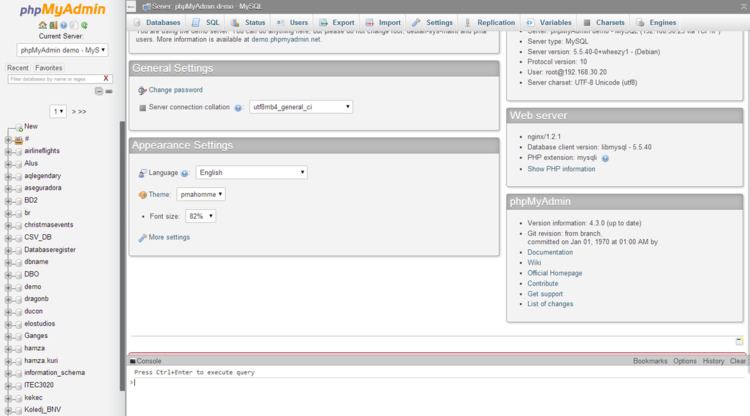Developer(s) The phpMyAdmin Project | Operating system | |
 | ||
Initial release September 9, 1998 (1998-09-09) Stable release 4.6.6 / January 23, 2017; 2 months ago (2017-01-23) Repository github.com/phpmyadmin/phpmyadmin Written in PHP, XHTML, CSS, JavaScript | ||
phpMyAdmin is a free and open source tool written in PHP intended to handle the administration of MySQL or MariaDB with the use of a web browser. It can perform various tasks such as creating, modifying or deleting databases, tables, fields or rows; executing SQL statements; or managing users and permissions.
Contents
History
Tobias Ratschiller, then an IT consultant and later founder of the software company Maguma, started to work on a PHP-based web front-end to MySQL in 1998, inspired by MySQL-Webadmin. He gave up the project (and phpAdsNew, of which he was also the original author) in 2000 because of lack of time.
By that time, phpMyAdmin had already become one of the most popular PHP applications and MySQL administration tools, with a large community of users and contributors. In order to coordinate the growing number of patches, a group of three developers registered The phpMyAdmin Project at SourceForge and took over the development in 2001.
In July 2015, the main website and the downloads left SourceForge and moved to a content delivery network. At the same time, the releases began to be PGP-signed. Afterwards, issue tracking moved to GitHub and the mailing lists migrated. Before version 4, which uses Ajax extensively to enhance usability, the software used HTML frames.
Features
Features provided by the program include:
- Web interface
- MySQL and MariaDB database management
- Import data from CSV and SQL
- Export data to various formats: CSV, SQL, XML, PDF (via the TCPDF library), ISO/IEC 26300 - OpenDocument Text and Spreadsheet, Word, Excel, LaTeX and others
- Administering multiple servers
- Creating PDF graphics of the database layout
- Creating complex queries using Query-by-Example (QBE)
- Searching globally in a database or a subset of it
- Transforming stored data into any format using a set of predefined functions, like displaying BLOB-data as image or download-link
- Live charts to monitor MySQL server activity like connections, processes, CPU/Memory usage, etc.
- Working with different operating systems.
Current status
The software, which is currently available in 78 languages, is maintained by The phpMyAdmin Project.
